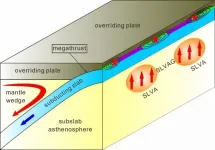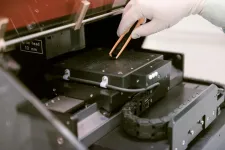(Press-News.org) A new way to identify tumours that could be sensitive to particular immunotherapies has been developed using data from thousands of NHS cancer patient samples sequenced through the 100,000 Genomes Project. The MMRDetect clinical algorithm makes it possible to identify tumours that have 'mismatch repair deficiencies' and then improve the personalisation of cancer therapies to exploit those weaknesses.
The study, led by researchers from the University of Cambridge's Department of Medical Genetics and MRC Cancer Unit, identified nine DNA repair genes that are critical guardians of the human genome from damage caused by oxygen and water, as well as errors during cell division.
The team used a genome editing technology, CRISPR-Cas9, to 'knock out' (make inoperative) these repair genes in healthy human stem cells. In doing so, they observed strong mutation patterns, or mutational signatures, which offer useful markers of those genes and the repair pathways they are involved in, failing.
The study, funded by Cancer Research UK and published today in the journal Nature Cancer, suggests that these signatures of repair pathway defects are on-going and could therefore serve as crucial biomarkers in precision medicine.
Senior author, Dr Serena Nik-Zainal, a Cancer Research UK Advanced Clinician Scientist at Cambridge University's MRC Cancer Unit, said: "When we knock out different DNA repair genes, we find a kind of fingerprint of that gene or pathway being erased. We can then use those fingerprints to figure out which repair pathways have stopped working in each person's tumour, and what treatments should be used specifically to treat their cancer."
The new computer algorithm, MMRDetect, uses the mutational signatures that were identified in the knock out experiments, and was trained on whole genome sequencing data from NHS cancer patients in the 100,000 Genomes Project, to identify tumours with 'mismatch repair deficiency' which makes them sensitive to checkpoint inhibitors, immunotherapies. Having developed the algorithm on tumours in this study, the plan now is to roll it out across all cancers picked up by Genomics England.
The breakthrough demonstrates the value of researchers working with the 100,000 Genomes Project, a pioneering national whole genome sequencing endeavour.
Parker Moss, Chief Commercial and Partnerships Officer at Genomics England, said: "We are very excited to see such impactful research being supported by the 100,000 Genomes Project, and that our data has helped to develop a clinically significant tool. This is a fantastic example of how the sheer size and richness of the 100,000 Genomes Project data can contribute to important research.
"The outcomes from Dr Nik-Zainal and her team's work demonstrate perfectly how quickly and effectively we can return value to patient care by bringing together a community of leading researchers through Genomics England's platform."
The study offers important insights into where DNA damage comes from in our bodies. Water and oxygen are essential for life but are also the biggest sources of internal DNA damage in humans.
Dr Nik-Zainal said: "Because we are alive, we need oxygen and water, yet they cause a constant drip of DNA damage in our cells. Our DNA repair pathways are normally working to limit that damage, which is why, when we knocked out some of the crucial genes, we immediately saw lots of mutations."
"Some DNA repair genes are like precision tools, able to fix very specific kinds of DNA damage. Human DNA has four building blocks: adenine, cytosine, guanine and thymine. As an example, the OGG1 gene has a very specific role of fixing guanine when it is damaged by oxygen. When we knocked out OGG1, this crucial defence was severely weakened resulting in a very specific pattern of guanines that had mutated into thymines throughout the genome."
To be most effective, the MMRDetect algorithm could be used as soon as a patient has received a cancer diagnosis and their tumour characterised by genome sequencing. The team believes that this tool could help to transform the way a wide range of cancers are treated and save many lives.
Michelle Mitchell, Chief Executive of Cancer Research UK, said: "Determining the right treatments for patients will give them the best chance of surviving their disease. Immunotherapy in particular can be powerful, but it doesn't work on everyone, so figuring out how to tell when it will work is vital to making it the most useful treatment it can be.
"Our ability to map and mine useful information from the genomes of tumours has improved massively over the past decade. Thanks to initiatives like the 100,000 Genomes Project, we are beginning to see how we might use this information to benefit patients. We look forward to seeing how this research develops, and its possibilities in helping future patients."
INFORMATION:
Australian scientists have unlocked another mystery of the class of microorganisms believed to be among Earth's oldest of life forms, throwing new light on the study of cell division and the evolution of life.
In a newly published paper in Nature Microbiology a research team from the iThree Institute at the University of Technology Sydney describes the cell division process used by the microorganism Haloferax volcanii from the archaea realm of single-celled life, which is distinct from bacteria.
Archaea make up the third major grouping, or domain, of life on the planet, alongside eukaryotes (including all plants and animals) and bacteria, but were only recognised ...
Earthquakes and volcanoes in subduction zones may cause great human catastrophe. Previous studies on subduction zone structure and causal mechanisms of giant megathrust earthquakes (M ≥ 9.0) have mainly focused on aspects like subducting plates and plate interfaces.
In contrast, the oceanic asthenosphere structure beneath the subducting slab (at depths of 100-250 km) and its influence on the nucleation of giant megathrust earthquakes have not been well studied.
Recently, Dr. FAN Jianke from the Institute of Oceanology of the Chinese Academy of Sciences (IOCAS) and Prof. ZHAO Dapeng from Tohoku University ...
Weight loss surgery is more effective than dieting to reduce brain pressure that can cause blindness in patients with a neurological condition, finds a study led by the University of Birmingham and University Hospitals Birmingham NHS Foundation Trust (UHB).
Idiopathic Intracranial Hypertension (IIH) is a debilitating condition that raises pressure in the brain and can lead to chronic headaches and even permanent sight loss. The illness, which often leaves patients with a reduced quality of life, predominately affects women aged 25 to 36 and weight gain is a major risk factor of developing IIH and relapses of the disease.
Weight ...
Sponges: They are considered to be one of the most primitive forms of animal life, because they have neither locomotion organs nor a nervous system. A team around deep-sea scientist Antje Boetius has now discovered that sponges leave trails on the sea floor in the Arctic deep sea. They conclude that the animals might move actively - even if only a few centimetres per year. They are now publishing these unique findings in the journal Current Biology.
The surprise was great when researchers looked at high-resolution images of the sea floor of the Arctic deep sea in detail: Path-like tracks across the sediments ended where sponges were located. These trails were observed to run in all directions, ...
Monday, 26 April 2021: A national study of 20,000 patients conducted by RCSI University of Medicine and Health Sciences and the HSE Health Protection Surveillance Centre (HPSC) has identified the underlying conditions that are associated with more severe outcomes from COVID-19 in an Irish setting.
The research, which has been published in The Lancet Regional Health - Europe, will help inform national public health policies and assist in future treatment and prevention strategies for people at most risk from the virus.
The study, which took place during the first wave of the pandemic between March and July 2020, is the first national surveillance study in Ireland that captures data from both hospital ...
MINNEAPOLIS/ST.PAUL (04/26/2021) -- A new study by five doctoral students in neuroscience at the University of Minnesota Medical School calls attention to a lack of regulation and unknown long-term health effects of tear gas. Based on their research, the group recommends changing the protocols around the use of tear gas as a crowd control measure at both the local and national level.
"Following the murder of George Floyd and the protests in our city, we felt compelled to dig into the police force used during those protests. We are trained to look at data and ...
A NUST MISIS professor was part of an international research team that has found evidence for the existence of the Zeeman spin-orbit coupling in antiferromagnetic conductors. This work may pave the way for the next generation of electronics. The study was published in npj Quantum Materials.
The electron possesses two fundamental properties: charge and spin. Conventional electronic devices use only the charge of electron for information processing. In recent years, an enormous research effort has been focused on building fundamentally new electronic devices (often called "spintronic devices") that would specifically exploit spin properties in addition to charge degrees of freedom. Transfer from conventional electronics to spintronics technology opens the possibilities to construct devices ...
BROOKLYN, New York, Thursday, April 22, 2021 - Rising sea levels and more powerful cyclonic storms, phenomena driven by the warming of oceans due to climate change, puts at immediate or potential risk an estimated 680 million people living in low-lying coastal zones (a number projected to reach more than one billion by 2050). In nations like Bangladesh these populations are already moving to escape sea-level rise.
In a new study, "Modeling human migration under environmental change: a case study of the effect of sea level rise in Bangladesh," researchers led by Maurizio Porfiri, an engineer at ...
Blood transfusions are a common procedure in medical practice in which donated blood is used to replace blood lost to injury or surgery or to treat serious medical conditions. The procedure is not performed as routinely in the treatment of pet cats - but, as in people, can be lifesaving. The availability of donors has been a limitation in primary care veterinary practice, but with the growth of blood banks providing greater access to feline blood, the procedure is likely to become more commonplace.
To address the need for authoritative guidance, not only on best practice but also some important considerations beyond the clinical procedure itself, the International Society of Feline Medicine (ISFM) has today published consensus guidelines in the Journal ...
From Cat's-Whisker detectors in the early 1900s to electronic circuit chips in modern-day mobile phones, electronic devices have been modified in myriad creative ways to adapt to the needs of humankind. Apart from increasing the efficiency of conventionally used semiconductors such as silicon, recent research has focused on exploring more cost effective semiconductor materials. In tune with these requirements, a new publication in Nature Materials has successfully tweaked low cost semiconducting materials, quite similar to the composition of plastic, into conducting electricity more efficiently than before.
Solar cells have the property to convert ...


